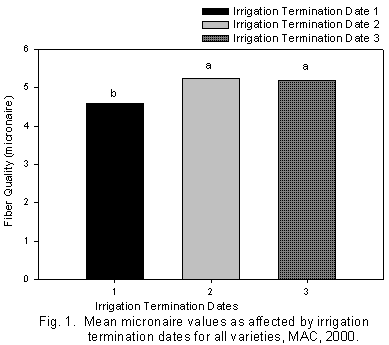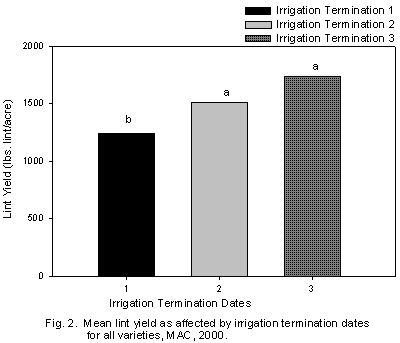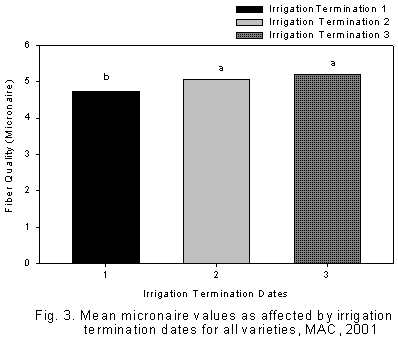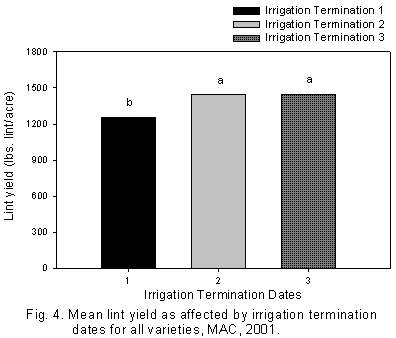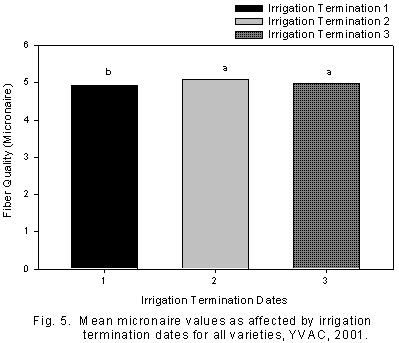Crop Management Impact on Fiber Micronaire
by Jeffrey C. Silvertooth,
Extension Agronomist, Professor & Head, SWES
High fiber micronaire has been a major problem in Arizona in recent years, causing substantial discounts to the lint value. A research project was initiated in 2000 to address this issue.
An experiment was conducted at the University of Arizona Maricopa Agricultural Center (MAC) in 2000 and 2001 and an additional site was added in 2001 at the Yuma Valley Agricultural Center (YVAC). The purpose of these experiments was to compare irrigation termination (IT) treatments (dates) in relation to lint yield and micronaire. In these experiments, irrigation termination treatments were imposed in relation to the crop fruiting cycle. The first IT treatment (IT1) was made with the intention of terminating irrigations somewhat prematurely. The IT2 treatment was managed to provide one additional irrigation past the more optimal date. For the IT3 plots, the intention was to attempt a second cycle fruit set and irrigations were continued until mid to late September in each case. The IT2 treatment received two additional irrigations over IT1 and IT3 received four additional irrigations over IT1 (approximately two acre-feet of additional irrigation water) for each site.
These experiments reveal several consistent and significant effects on micronaire and lint yield due to IT and variety. Average mic values were consistently lowest for IT1 (consistently below 5.0) and generally increased with later IT dates (Figures 1, 3, and 5). Lint yields generally increased with later IT, but not always significantly (Figures 2, 4, and 6). Fiber strength was not affected by IT treatments.
From the IT X Variety experiments and statewide crop management studies that have been conducted with grower-cooperator sites, several factors have shown strong relationships to fiber micronaire on a consistent basis. These factors include:
- Heat units accumulated after planting (HUAP) to irrigation termination.
- In general, as HUAP increased, micronaire increased also.
- The number of green bolls on the plant as the crop approached cut-out.
- As the number of green bolls increased, the micronaire tended to be lower
- The position of the first fruiting branch.
- With lower first fruiting branch, micronaire tended to be lower.
- Variety
General recommendations regarding yield and mic for growers to consider include:
- Consider variety selection carefully
- Manage for early fruiting
- Monitor early fruiting
- Watch for and identify any terminal damage (can delay fruiting)
- Manage for a uniform fruiting pattern (avoid fruiting gaps)
- Water management
- Fertility management
- Pest control
- Monitor fruit set (retention) as crop approaches cut-out
- Evaluate crop condition at cut-out when considering a top-crop
Issued in furtherance of Cooperative Extension work, acts of May 8 and June 30, 1914, in cooperation with the U.S. Department of Agriculture, James A. Christenson, Director Cooperative Extension, College of Agriculture and Life Sciences, The University of Arizona.
The University of Arizona is an equal opportunity, affirmative action institution. The University does not discriminate on the basis of race, color, religion, sex, national origin, age, disability, veteran status, or sexual orientation in its programs and activities.
Any products, services, or organizations that are
mentioned, shown, or indirectly implied in this web document do not imply
endorsement by The University of Arizona.
Information provided by Jeffrey C. Silvertooth, silver@ag.arizona.edu
Extension Agronomist, Professor & Head, SWES, College of Agriculture and Life Sciences, The University of Arizona.
Material written March 4, 2002.
Crop Mgmt | Soil Mgmt | Irrigation | Varieties | Cotton Comments
Home | Cotton | Advisories
document located at: http://cals.arizona.edu/crops/cotton/comments/mar2002cc.html
Copyright © 2001 University of Arizona,
College of Agriculture and Life Sciences
Webmaster: Al Fournier (acis@ag.arizona.edu)
